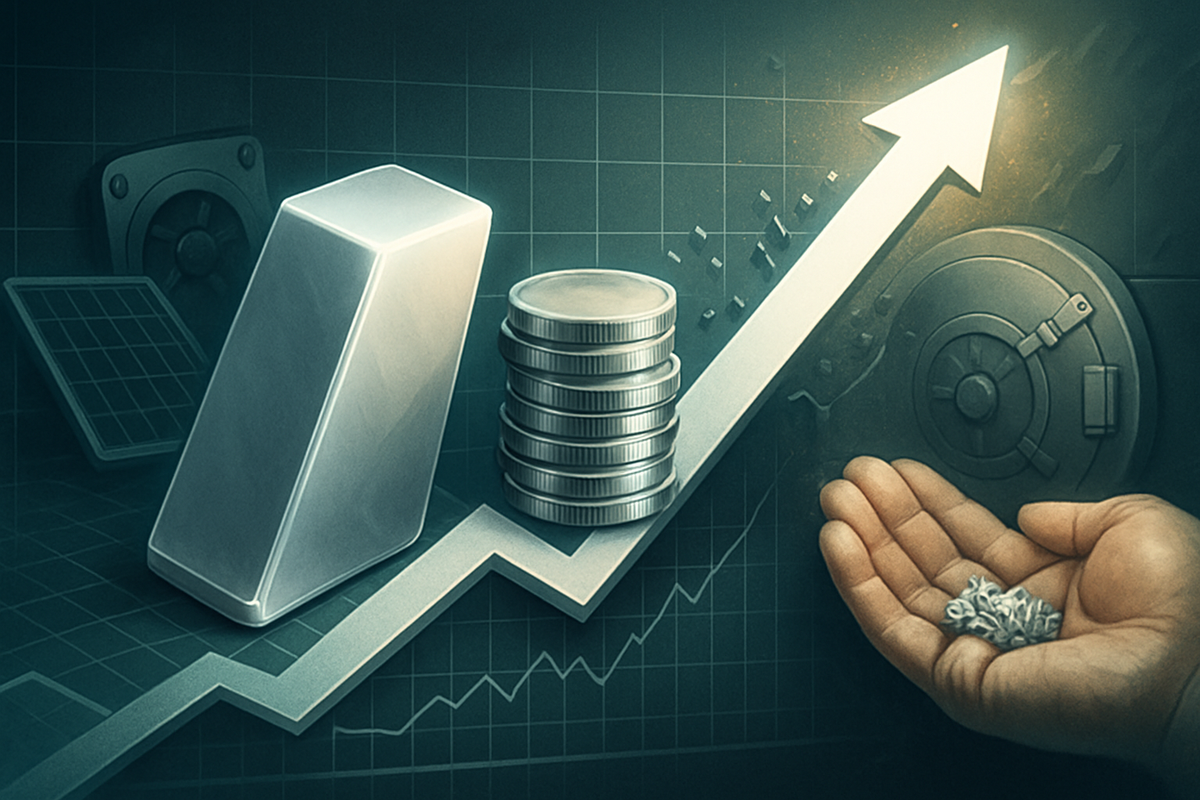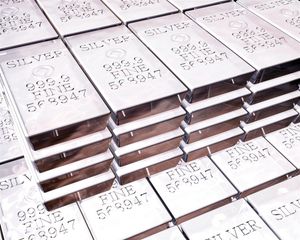
The year 2025 has cemented its place in financial history as silver, often dubbed "poor man's gold," embarked on an astonishing rally, surging over 70% year-to-date and shattering multi-decade records. As of mid-October 2025, the precious metal has soared past the psychological $50 per ounce barrier, with some reports indicating an all-time high of $52.58 or even $53.50 per ounce. This dramatic ascent reflects a profound re-evaluation of silver's intrinsic value, driven by a potent cocktail of tightening physical supply, insatiable industrial demand, and a renewed investor flight to safety amidst global economic and geopolitical uncertainties. The immediate implications are a heightened sense of volatility across financial markets, a significant boost for silver miners, and mounting cost pressures for industries heavily reliant on the white metal.
This historic surge is not merely a speculative froth; it is underpinned by a fundamental demand-supply imbalance that has been building for years. The market is currently experiencing a "historic short squeeze" in London, characterized by severe physical supply shortages, critically low inventories, and lease rates skyrocketing past 30%. This unique confluence of factors is forcing short sellers to cover positions at escalating prices, leading to substantial profits for physical silver holders and a challenging landscape for those caught on the wrong side of the trade. The rally underscores a broader shift in investor sentiment, reflecting anxieties over economic stability, inflationary pressures, and a growing distrust in traditional financial systems, positioning silver as an indispensable diversification tool.
Unpacking the Silver Tsunami: A Year of Unprecedented Gains
The 2025 silver surge has been nothing short of spectacular, with the metal's price movements defying conventional expectations. After years of trading significantly below its all-time highs, silver began its aggressive ascent early in the year, steadily gaining momentum as global economic indicators signaled persistent inflation and geopolitical tensions escalated. By mid-October, the spot price had not only surpassed its 1980 record of $49.45 per ounce but also briefly touched an all-time nominal high of $52.58 in London markets, a testament to the sheer force of current market dynamics.
A crucial factor contributing to this rally is the enduring structural deficit in the silver market, now in its fifth consecutive year (2021-2025). Mine production has been on a decline, impacted by factors such as lower ore grades and the closure of some copper mines, where silver is often extracted as a byproduct. Concurrently, overall demand, particularly from industrial applications and investment, has consistently outpaced supply. This imbalance has led to critically low above-ground inventories, especially in major trading hubs like London, where physical silver holdings have reportedly dropped by 33% since 2021. The "silver market squeeze" in London has seen lease rates for physical silver skyrocket, reflecting the desperation of institutions needing to source the metal. This has created a significant premium for physical silver in London compared to futures contracts in New York, a clear indicator of the market's physical tightness. Initial market reactions have been a mix of bullish enthusiasm from analysts, with some revising price targets upwards, and caution from industrial users grappling with soaring input costs.
Key players in this unfolding drama include large institutional investors and hedge funds increasing their long positions, individual retail investors driven by safe-haven demand, and central banks diversifying their reserves. On the supply side, major silver mining companies are enjoying windfall profits, while industrial consumers, such as solar panel and electric vehicle manufacturers, are facing immense pressure. The London Bullion Market Association (LBMA) and various commodity exchanges are also central to the market dynamics, managing the flow and pricing of silver.
Winners and Losers: Corporate Fortunes in a Bullish Silver Market
The historic 2025 silver surge has created a stark divergence in fortunes across various public companies, enriching primary silver producers while burdening industrial users.
The Winners: Silver Mining Companies Silver mining companies are undoubtedly the primary beneficiaries of this price explosion. Higher silver prices directly translate into increased revenues and significantly expanded profit margins, boosting their profitability and stock performance. Many producers are now operating with production costs well below the current spot prices, leading to substantial "windfall profits."
- Pan American Silver (TSX: PAAS, NYSE: PAAS): As one of the world's largest primary silver producers, Pan American Silver is experiencing a highly positive impact. Its acquisition of a 44% stake in the high-grade Juanicipio mine in January 2025 has further solidified its position, with analysts projecting significant year-over-year growth in sales and EPS for 2025.
- First Majestic Silver (TSX: AG, NYSE: AG): With its primary silver-producing mines in Mexico, First Majestic Silver is seeing substantial gains. Its focus on production growth and aggressive cost management makes it a direct beneficiary of the rally.
- Fresnillo plc (LSE: FRES): The world's largest primary silver producer, operating mainly in Mexico, is well-positioned, with expected increases in annual output further bolstering its share prices.
- MAG Silver (TSX: MAG, NYSEAMERICAN: MAG): Holding a 44% stake in the high-grade Juanicipio mine, MAG Silver continues to be positively impacted by the direct increase in the value of its producing asset.
- Buenaventura Mining Company Inc. (NYSE: BVN): One of Peru's leading precious metals companies with significant silver exposure, Buenaventura is also forecast for strong sales and EPS growth. Other notable beneficiaries include Industrias Penoles, Wheaton Precious Metals Corp. (TSX: WPM, NYSE: WPM), Fortuna Silver Mines (TSX: FSM, NYSE: FSM), Coeur Mining (NYSE: CDE), and Hecla Mining (NYSE: HL), all poised for improved financial health.
The Losers: Industrial Users Conversely, industrial users of silver, particularly manufacturers in the green energy and electronics sectors, are facing significant negative impacts due to surging input costs.
- Solar Panel Manufacturers: Companies like JinkoSolar, JA Solar, Trina Solar, Tongwei Solar, Canadian Solar (NASDAQ: CSIQ), and First Solar (NASDAQ: FSLR) are particularly vulnerable. Silver now accounts for a substantial portion of solar module production costs, up from 5% in 2023 to 14% in 2025. This cost escalation threatens to squeeze profit margins and accelerate efforts to reduce silver content or find alternative materials.
- Electric Vehicle (EV) Manufacturers: BYD (HKG: 1211), Tesla (NASDAQ: TSLA), General Motors (NYSE: GM), Volkswagen (ETR: VOW3), Geely Auto Group (HKG: 0175), Hyundai Motors (KRX: 005380), and Ford Motor Company (NYSE: F) are also grappling with increased production expenses. EVs use more silver than traditional vehicles, and the rising cost impacts their profitability and potentially leads to higher vehicle prices or pressure for material innovation.
Mixed Impact: Financial Institutions Financial institutions involved in silver trading face both opportunities and risks. Increased volatility creates trading opportunities for banks, hedge funds, and proprietary trading firms. However, those with significant short positions or physical delivery obligations in the tight London market are exposed to substantial losses due to skyrocketing lease rates and physical shortages. Institutions like JPMorgan Chase (NYSE: JPM), Bank of Nova Scotia (TSX: BNS, NYSE: BNS), HSBC (LSE: HSBA), UBS (SWX: UBSG), and Deutsche Bank (ETR: DBK) are navigating this high-stakes environment. Meanwhile, exchanges like CME Group (NASDAQ: CME) benefit from increased trading volumes, and brokerage firms like Charles Schwab (NYSE: SCHW) and Fidelity Investments see higher client activity in silver-related products.
Wider Significance: A Reflection of Global Shifts
The 2025 silver surge is far more than a mere commodity price spike; it is a profound indicator of broader industry trends, macroeconomic shifts, and evolving global priorities. Its significance resonates across green energy, inflation dynamics, and the stability of critical supply chains.
Intertwined with Green Energy and Inflation: Silver's indispensable role in the global transition to green energy is a primary driver. The solar photovoltaic (PV) industry, in particular, is a voracious consumer, with solar panels accounting for nearly half of global silver consumption in 2025. Projections indicate massive solar capacity additions in the coming years, each gigawatt requiring significant amounts of silver. Similarly, electric vehicles (EVs) utilize double the silver of traditional cars, integrating it into critical components. As governments worldwide push aggressive green energy targets, demand for silver is structurally amplified. Concurrently, persistent global inflationary pressures, coupled with geopolitical instability, concerns over global debt, and a weakening U.S. dollar, have driven investors to seek refuge in precious metals as a hedge, bolstering silver's safe-haven appeal. Expectations of potential Federal Reserve interest rate cuts further enhance the attractiveness of non-yielding assets.
Ripple Effects and Competitive Landscape: The surge has created significant ripple effects. While silver has dramatically outperformed gold in 2025 (70-76% vs. 40-55% gains), the entire precious metals complex has seen robust momentum, with gold also reaching record highs above $4,000 per ounce. This dynamic often sees silver outperforming gold percentage-wise during bull markets due to its smaller market size and greater industrial leverage. For industries reliant on silver, such as solar panel manufacturers, the increased costs are compelling them to accelerate "thrifting" efforts (reducing silver content) and explore alternative materials like copper and nickel. While research suggests silver reduction is possible without compromising quality, the pressure is immense. The electronics and EV industries are also grappling with higher input costs, which could influence production strategies and pricing.
Regulatory and Policy Implications: The "historic short squeeze" in the London market, characterized by severe physical shortages and soaring lease rates, has drawn regulatory attention. It highlights the potential for increased scrutiny of futures markets to prevent excessive speculation in physically constrained commodities. Furthermore, the tightness in supply chains for critical industrial metals like silver underscores the need for policies focused on resource security and supply chain resilience. Lingering uncertainties surrounding critical mineral designations and potential tariffs earlier in 2025 also influenced market behavior, causing inventory dislocations.
Historical Precedents: The 2025 silver rally has broken nominal price records last seen during the tumultuous markets of 1980 (the Hunt brothers' attempt to corner the market) and briefly in 2011. Historically, significant silver surges have often coincided with periods of economic instability, high inflation, and geopolitical tensions. However, a key differentiator for the 2025 surge is the robust and accelerating structural industrial demand, particularly from the green energy sector, which provides a stronger fundamental underpinning compared to past, more speculative rallies. Silver's inherent volatility, typically moving 1.7 times faster than gold, remains a constant, offering both amplified opportunities and risks.
What Comes Next: Navigating the Future of Silver
The unprecedented 2025 silver surge sets the stage for a dynamic future, marked by both opportunities and challenges across various sectors. The short-term will likely see continued volatility, while the long-term trajectory appears bullish, driven by fundamental shifts.
Short-Term Possibilities: In the immediate aftermath, profit-taking by short-term investors could lead to temporary price pullbacks, though strong underlying demand is expected to provide support. The intensified supply squeeze, particularly in the London market, will likely persist, potentially leading to further backwardation and higher borrowing costs for physical silver. Industrial users will double down on "thrifting" efforts and material substitution, though widespread adoption of alternatives will take time. This period will also see heightened investor scrutiny, potentially drawing more capital into the silver market as a hedge against ongoing economic uncertainties and inflation.
Long-Term Possibilities: The long-term outlook for silver remains robust. The structural demand from the green economy – solar, EVs, 5G, and advanced electronics – is projected to remain strong, creating an "inelastic demand base" that supports prices. Despite efforts at substitution, silver's unique properties make it difficult to replace entirely in many critical applications. The supply-demand imbalance is expected to continue, as mine production, largely a byproduct, cannot rapidly scale to meet surging demand. This fundamental deficit is a powerful long-term bullish factor. High prices will also incentivize greater investment in silver recycling technologies and exploration for new deposits, though these have long lead times.
Strategic Pivots for Industries:
- Solar Industry: Manufacturers must accelerate R&D into silver reduction per cell and explore alternative metallization approaches using copper, nickel, or hybrid solutions. Process optimization will be key to maintaining quality with less silver.
- Electronics and Automotive: These sectors will need to invest in research for substitutes, enhance recycling infrastructure for end-of-life products, and implement sophisticated hedging strategies to manage price volatility.
- Mining Companies: Sustained high prices will encourage investment in new primary silver mines and expansion of existing operations, as well as optimizing silver recovery from byproduct operations.
Market Opportunities and Challenges: Opportunities include the viability of previously uneconomical silver deposits, growth in silver recycling ventures, and sustained demand from rapidly industrializing emerging economies. Challenges include increased production costs for net silver importers, potential geopolitical disruptions to supply chains, and the inherent volatility of the silver market.
Potential Scenarios:
- Bullish Scenario: Silver prices could consolidate around $50-$55 in 2026 and move towards $77-$88 by 2027-2030, potentially reaching $100 by late 2026, driven by persistent deficits, accelerating green tech demand, and sustained safe-haven interest.
- Moderate Scenario: Prices could hover in a slightly lower but still elevated range, with "thrifting" efforts partially mitigating demand and investment flows stabilizing.
- Bearish Scenario: Less likely in the current environment, but a significant global economic downturn, rapid and widespread adoption of cheap silver substitutes, or a sudden surge in mine supply could lead to price corrections.
Comprehensive Wrap-up: Silver's Enduring Significance
The 2025 silver surge marks a pivotal moment in the precious metals market, solidifying silver's dual identity as both a crucial industrial commodity driving the green revolution and a traditional safe-haven asset amidst global economic turbulence. Its historic 70% gain year-to-date, pushing prices above $50 per ounce and to new nominal all-time highs, is a powerful testament to its evolving significance.
Key Takeaways: The rally is fundamentally driven by a severe and persistent supply deficit, accelerating industrial demand from solar and electric vehicle sectors, and robust investment demand fueled by inflation concerns and geopolitical instability. The "historic short squeeze" in the London market, characterized by critically low inventories and soaring lease rates, underscores the physical tightness of the market. Expectations of lower interest rates from central banks further enhance silver's appeal by reducing the opportunity cost of holding non-yielding assets.
Market Moving Forward: The consensus among analysts points to a sustained bullish outlook for silver, with price targets ranging from $60 to $65 per ounce by 2026, and even higher in the long term. However, investors should anticipate continued volatility, with potential for short-term corrections given the rapid ascent. The market is expected to remain in deficit for the foreseeable future, as mining production struggles to keep pace with demand.
Lasting Impact: This surge is likely to lead to a lasting re-evaluation of silver's intrinsic value, cementing its role in the global economy. It will accelerate innovation in material science for industries seeking to reduce silver content and highlight the critical importance of secure supply chains for essential industrial metals. The market's dynamics, including the gold-to-silver ratio, may also undergo a structural shift, favoring silver's relative performance.
What Investors Should Watch For: In the coming months, investors should closely monitor Federal Reserve monetary policy, particularly the timing and magnitude of interest rate cuts, as well as global economic indicators that influence industrial demand. Geopolitical developments will continue to shape safe-haven demand. Crucially, watch for trends in industrial consumption, especially in the solar and EV sectors, and any significant advancements in silver substitution or recycling technologies. Finally, keep a keen eye on supply-side responses, above-ground inventory levels, and the ongoing dynamics of the London physical silver market, as these will be key determinants of future price action.
This content is intended for informational purposes only and is not financial advice






